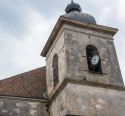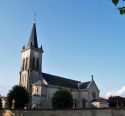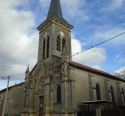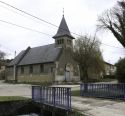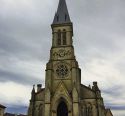Treasures of the Sammiellois
Come and (re)discover some of the churches open within a 25km radius of Saint-Mihiel on this tour.
You'll be amazed by the richness of these buildings, from the inter-war period to the decorations created by the Donzelli family, or those created in the 16th century by Ligier Richier.
Let yourself be guided along the beautiful roads of the Meuse to admire the varied landscapes, in the midst of which a bell tower regularly stands out to be admired.
Translated with www.DeepL.com/Translator (free version)
-
Saint-Michel from Saint-Mihiel
Saint-Michel Church got some remarkable furniture including 80 choir stalls and choir wooden work from 1710 and a walnut sculpture from Liger Richier depicting "The Virgin swoon": one of the most prominent Renaissance wooden work. You can also admire a monument by Liger Richier's grandson (date 1608) and two organs. The "grand organ" from the end of the 17th century is one of the most beautiful organs in Europe with its richly decorated organ cabinet and its two independent pedal turrets. Actually money is collected by the "Patrimony Foundation.
-
Saint-Etienne from Spada
The primitive church was destroyed during the 1st World War and rebuilt in 1924. It's decorated with frescoes realized by Duilio Donzelli. The most beautiful one is a "Pieta" (Virgin supporting Christ) created by a Flemish sculptor Jean Crocq who lived at the court of the Duke René II. This "Pieta" is a polychrome work with a particularity: a veil in the Virgin's hand to mop Christ's face. We can find it in only three churches: Vassincourt, Louppy-sur-Loison and Spada.
-
Saint Rémi from Koeur-la-Petite
Situated in the center of the village, the church, built in 1770 with the stones of the old castle, is reflected in the "Gayoir". Damaged during the two world conflicts, it has been restored each time. Two commemorative glass windows illustrate the end of these conflicts. The first one, created in 1952 by a master glassmaker from Nancy, the Benoît frères studio, represents Saint-Martin ordering the armistice on the banks of the Rhine; the second one represents "Sainte Jeanne d'Arc". We can also admire an oil on canvas of the 17th century, the apparition of the child Jesus to "Saint Antoine de Padoue", inspired by Murillo.
-
Saint Laurent from Rouvrais-sur-Meuse
The actual church was rebuilt in 1926 on the ruins of the old one destroyed in 1914. There are wonderful wall paintings realized by Duilio and Donzelli (1931). In its choir and in the side chapels: They symbolize Christ's Royalty. The orange color of its vault shines with the light of the stained glass windows and give a wonderful ton to the vault when the sun sets. To see in the village: suspended floor washstand.
-
Saint-Pierre from Spada
The primitive church was destroyed during the 1st World War and rebuilt in 1924. It's decorated with frescoes realized by Duilio Donzelli. The most beautiful one is a "Pieta" (Virgin supporting Christ) created by a Flemish sculptor Jean Crocq who lived at the court of the Duke René II. This "Pieta" is a polychrome work with a particularity: a veil in the Virgin's hand to mop Christ's face. We can find it in only three churches: Vassincourt, Louppy-sur-Loison and Spada.
-
Sainte Marie-Madeleine from Lamorville
The primitive church dates from 1760. The choir and the arches were modified in 1819. Destroyed in 1914, it was rebuilt in 1922. Its nave was decorated by Duilio Donzelli. The city of Yvetot, godmother of war, offered a bell and a church window for the choir (destroyed during the 2nd world war).
-
Saint-Pierre from Dompierre-aux-Bois
The ancient church was destroyed in 1914 by a French bombing raid against the Germans. A French shell burst out in the church on the 27th September 1914 (22 deae 94 wounded) this action is painted on one of the church stained glasses. The actual church has been rebullt on the foundations of the old one. In the choir, you can admire the old high altar and the two small side altars (dedicated to the virgin and Saint Joseph.
-
Saint Marcel from Seuzey
Destroyed during the First World War, it was rebuilt in 1933 with its bell tower, its open porch on the sides: it is a neo-roman model-type barn without column. Duilio Donzelli realized several artistic remarkable pictures. The church glasses were created by the "Maitre Verrier" Georges Janin (date 1935). The church has an organ which looks like a tribune. The high altar and the two small ones were realized by Duilio Donzelli and are made of white calcareous rock. (The baptismal fonts and the stoups, too).
-
Saint Jean-baptiste from Lacroix
The church has been rebuilt on the same place as the old one from the 17t century by François Langard, Priest of Lacroix-sur-Meuse from 1843 to 1872, in the direction of the diocesan architect of Bar-le-Duc M. MAXE The church was blessed by Monseigneur Rosat (Bishop of Verdun), but during the First World War was spoilt her. The Tombstone comes from Etienne II's grave (Rosières), the Lord of Lacroix. A chair to preach (neo-gothic style) realized thanks to Abbe François Langard. We can admire three Rosettes: One of them on the portal represents the "Eternal Father" surrounded with three angel heads. The paintings on the small altars and in the choir were realized by Duilio Donzelli 20*h century. You can also visit: Donzelli's Foutains and Monuments.
-
Saint-Privat de Bislée church
This small rural church, destroyed during the First World War and rebuilt in 1920, was renovated in 2023, highlighting its Romanesque-style façade and the restored stained glass windows visible from the outside in the evening.
-
Saint-Évre church in Mécrin
The church in the village of Mécrin is unique in the richness of its decoration. Devastated by the Great War, the church in Mécrin was restored in the 1920s. To mark the occasion, the interior of the vast new building was entirely painted. The walls are covered with scenes from the Old Testament and symbolic representations of Christian iconography. They are the work of the now world-famous artist Duilio Donzelli.



